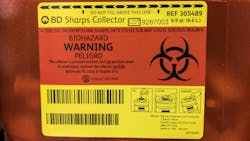A simple, easy-to-use medical waste disposal option
Medical waste disposal is a part of just about every dental practice in the United States. Dentists know the standard procedure: they dispose of needles and other types of regulated medical waste in their practice by putting them into sharps containers. Once the sharps container is full, they move it to their back room and often wait for their contracted company to come haul the waste away. Sometime later, they get a returned manifest hopefully stating that all went well, and their waste was properly disposed of. While this is indeed the process that so many doctors are familiar with, few understand what led to the current system and the alternatives that are available.
Waste management through time
Waste management was largely ignored in the US until a mere 60 or so years ago when the Solid Waste Disposal Act of 1965 was first enacted. Significant legislation came 11 years later in the form of the Resource Conservation and Recovery Act (RCRA) of 1976, which amended the original Solid Waste Disposal Act. This amendment aimed to introduce future regulation to protect humans and the environment from threats posed by hazardous waste disposal, conserve natural resources and reduce the waste we generate, and ensure that the waste is managed in an environmentally friendly manner. This act brought forth the idea of a “cradle-to-grave” system for hazardous waste—monitoring and regulating said waste from the time it’s created to the time it’s eventually sterilized and destroyed.
Despite efforts to enforce this, there were alarming gaps in the system. Along the East Coast, pieces of medical waste such as needles were washing up on beaches and posing a substantial threat to the public. This in turn led to the 1988 Medical Waste Tracking Act, where the US Environmental Protection Agency (EPA) monitored medical waste production and disposal so they could identify the best way to tighten the surrounding safety procedures. They found that the best way to control medical waste was to crack down on those producing it.
In 1991, the EPA put forth guidelines for new definitions of medical waste, standards for tracking, labeling, separating, and storing medical waste, and new penalties for failing to comply with the safety protocols. This was the origin of the medical waste manifests that so many doctors treating their waste with third-party haulers are familiar with. Manifests track any waste that leaves a facility still classified as medical waste and ensure that practices not staying compliant are held responsible.
After the EPA concluded their study and made their recommendations, they largely left enforcement up to each state. Today we see a wide range of laws, recommendations, and solutions for safe disposal. Many practices utilize third-party hauling companies where they sign on for a multiyear contract and have a company pick up their stored waste on a scheduled basis and bring it to an industrial incinerator. Some practices opt to send their untreated medical waste through the postal system using a mail-back program.
An easy alternative for medical waste disposal
For my practice, I sought to find an alternative. Back in 2014, I was frustrated with the ever-increasing cost of my medical waste disposal and started exploring options to get away from the “big” sterilization company. I read an article about a machine that was eco-friendly, easy to use, and would save me money overall.
I decided to try a countertop disposal system simply called The Medical Waste Machine from Medical Innovations, Inc. It’s a countertop machine that you can put your sharps and medical waste into with a little plastic indicator disc that looks almost like a hockey puck. We still use a small plastic sharps container to collect needles and medical waste in each of our treatment rooms, but once the sharps container is filled, we now treat it in the office.
The machine also comes with a second canister that can be filled directly, which is useful for the larger disposable syringes used for Botox. The machine runs off a one-button process, which my staff loves, and after it’s cooked the waste for a few hours, you’re left with a solid block that is sterile and inert—no longer classified as regulated medical waste! You can throw the block away with normal solid waste, and that’s it.
Explore your options
Finding a medical waste solution that worked for me and implementing this machine was one of the best decisions I’ve made for my practice. Whether you go with a hauler, a mail-back program, or an in-house solution, I always recommend that my colleagues explore their options and educate themselves on the vast number of solutions to this and the many other issues in our ever-changing field.
About the Author
Jennifer L. Pottinger, DDS
Jennifer L. Pottinger, DDS, is a general dentist from Overland Park, Kansas. She graduated from the University of Missouri-Kansas City in 1997. She is a member of the Kansas Dental Association, American Dental Association, Great Plains Study Club (part of Seattle Study Club), and OMBID.
